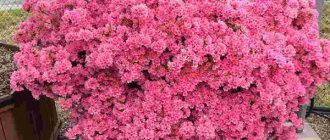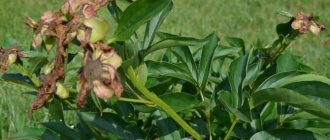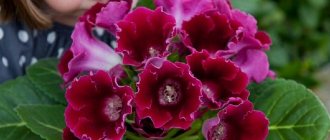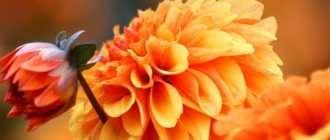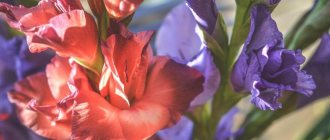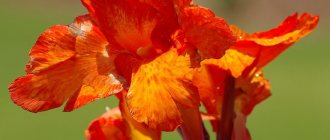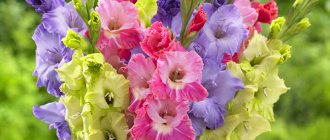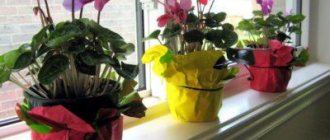Gloxinia has faded, what to do next?
The 21st century is a time of high technology and constant movement, so everyone, from the average clerk to the desperate housewife, experiences stress. Some people are in this state permanently, others are “overcome” in places, and psychologists advise both of them on ways to get out of it. Sports, interest groups or having a pet. But what should those who do not have the time and energy for all of the above do? An excellent solution is a houseplant. Spathiphyllum, violets, ficus, or maybe exotic gloxinia?! It will delight its owner not only with beautiful, unusual flowers, but also with an incomparable aroma. It is not surprising that after gloxinia has faded, what to do next is perhaps the most popular question, both among beginners and among already experienced gardeners.
Good signs about indoor plants
Rhassula, Crassula,
The fern protects against harmful radiation from electrical appliances, so place it near the TV or computer. This property allows them to replace the usual cacti; negative signs are associated with them.
Another name for spathiphyllum is women's happiness. This plant carries one positive energy - it brings family happiness and prosperity. You can read more about the meaning of spathiphyllum in a separate article on the website.
Bamboo carries the energy of career growth, the desire for success and good luck in business and at work. But it brings happiness when a pot with a plant is placed on the desktop. In the bedroom, near the bed, such aspirations are useless.
Aloe serves as a normalizer for family relationships and communication with guests, and brings peace and tranquility to the home. This plant will protect against unwanted visitors and their influence. Therefore, they are placed near the entrance to the room.
Breed sour wood when you have problems finding a suitable partner or in a relationship with the existing one. It normalizes family and love relationships.
Hibiscus is a flower of love and passion. Perfect for newlyweds and older couples. Helps in strengthening and restoring normal family relationships. Avocado has a similar meaning.
Tradescantia protects the owner from gossip, and aspidistra adds strength to character.
Ficus is a plant that gave Adam and Eve leaves to hide their nakedness and fruits (figs are a type of ficus) to satisfy hunger. It is considered the patron of the hearth and home, bringing prosperity and good luck. Read about the signs about ficus trees.
Chlorophytum purifies the air and, according to signs, brings happiness to family members.
Violet helps resolve conflicts peacefully. When there are scandals in the house, plant violets. Find out about the signs about violets.
Geranium fights stress, loneliness and depression, and also boosts confidence. It makes a person’s character calm and balanced.
Dracaena improves mood, shares energy, brings good luck and success.
All citrus plants are favorable for placement in the home. They bring good luck, happiness, wealth and love.
House roses symbolize fidelity and chastity. When you are worried about your teenage daughter, place a box of roses, preferably white ones, in her room. In the matrimonial bedroom, marriage is protected from betrayal and deception.
Gloxinia description, photo
Gloxinia flowers can be very unusual, velvety or, on the contrary, simple and smooth. The palette of this beautiful plant is varied, from small white buds to huge purple ones. This perennial herbaceous plant either has no stem at all or a very short one. It can have many large flowers (the number can reach up to 50), with bright perianths, or a single beautiful flower.
Gloxinia leaves are green, bizarrely shaped, as if created to emphasize the unique shape of the “bells”. This is a tuberous plant that loves the sun's rays.
Attention! Despite the fact that gloxinia is photophilous, it is afraid of direct sunlight. If you place a flower in the southern part of the house, under the “open sun,” the plant risks getting burned and dying.
The homeland of this miracle plant is Brazil, although it can often be found in South America. Garden gloxinia (genus Sinningia) is popular among us, as it requires no less, although diametrically opposed, care than its domestic counterparts.
Types of Gloxinia
In general, there are more than 25 species of this flower, and each of them has its own characteristics and requires individual, careful care. It just so happens that terry gloxinias are especially popular in our country. A distinctive feature of this type of plant is the large number of petals. Today, more than 70 varieties of this particular type of flower are known.
Terry gloxinia, depending on color, can be divided into the following subspecies:
- calico;
- brindle;
- plain.
Calicos owe their name to the presence of various dots and specks on their surface; plain ones, as you might guess, do not have this feature; their buds are painted exclusively in one color. And tiger ones are decorated not only with all kinds of small spots, but also with rims around the edge of the flower. There is a direct relationship between the “fastidiousness of a flower” (demandingness in care) and its color. Gloxinia flowers have either the shape of a bell (they are more common) or tidea (popularly a slipper).
Important to remember! Plant care and its life cycle may vary depending on the type and variety of the plant.
The most popular and favorite varieties of gloxinia include the following:
- Winter cherry;
- Yesenia;
- Gloxinia tiny;
- gloxinia perennis;
- gloxinia regal;
- gloxinia beautiful;
- South night;
- Cleopatra;
- Triumph Tender;
- Kristin Ireland;
- Pink Flamingo.
Winter cherry - there are suggestions that this variety was bred from Purple beads, hence the similarity in color, white flowers, as if deliberately strewn with burgundy peas. It is considered semi-miniature, has medium-sized buds and medium-sized green leaves with a fleecy surface.
Yesenia - the petioles of this gloxinia are medium, it grows as a small bush, the bud shape is gramophone. Legends can be made about the rich color and size of the flowers of this plant, especially since they are ready to please the owner with their flowers for a long time.
Gloxinia is tiny - this decorative representative of the species barely reaches 2.5 cm in length. On small pedicels there is one miniature flower, which contrasts quite strongly with the velvet leaves, oval in shape. The color of the petals is from light lilac to blue-violet, the throat is white.
Gloxinia perennis (Speckled Gloxinia) is quite large, compared to others, it can reach up to 70 cm in length. During the flowering period, it blooms beautiful pale blue bell flowers (several on one stem) and pampers with the intoxicating aroma of mint. The leaves also have a rather unusual color, with a glossy green top and red bottom.
Gloxinia royal - grows as a bush, the height can reach up to 30 cm. A silver pattern is visible on the dark green heart-shaped leaf. The flowers are bell-shaped, dark purple, large, up to 7 cm in diameter. With proper care it blooms profusely and for a long time.
Gloxinia is beautiful - the color scheme of this queen is truly diverse, from small white or scarlet flowers to bright two-color or purple. The leaves are heart-shaped at the base and diverge into a beautiful oval towards the end. The length of the bell-shaped flower can reach up to 5 cm, the bud seems to stretch towards the sun (pointed upward). Depending on the variety, size and color may vary.
Southern Night - This species has gained popularity due to its rich purple color. Large velvet petals are covered with barely noticeable specks.
Cleopatra - due to the fact that this is an artificially bred plant, caring for this gloxinia should be especially careful. The beautiful wavy petals are notable not only for their shape, but also for their semolina colors (they can be white, light pink, and some representatives of the species have small, pronounced dots that turn into stripes closer to the edge). Despite the straight flower stalks, Cleopatra resembles a bouquet. With proper care it blooms vigorously and for a long time.
Triumph Tender - this gloxinia is sometimes compared to an apple tree flower, it’s all white (marshmallow color), with a soft pink tint; if you look closely, you can see small veins on the petals and dark specks. Flower growers compare its bud to cotton wool and do not call it anything other than “delicate.” A very heat-loving plant, changes in temperature are fraught with sticking of the petals and poor opening of the bud.
Kristin Irish - if you manage to cope with the vagaries of this gloxinia, then as a reward the gardener will receive white, densely double flowers, with a bright crimson border. The plant has a shortened peduncle, making the bush look compact. Can reach up to 25 cm in height.
Pink Flamingo - the name speaks for itself, this is a stunning flower of deep pink color, sometimes has a purple tint, it all depends on the care and conditions in which the plant is located, it has long flower stalks - so you need to take care of support for them. The leaves are green, dense and medium in size.
Interesting fact! In the 18th century, a gift of gloxinia meant a declaration of love at first sight.
Gloxinia flowering period at home
At the end of February, the plant begins its growing season and when 2-3 leaves appear, gloxinia buds begin to form. If this happens within the standard time frame, the plant may bloom again in August. To do this, you need to help him.
Gloxinia needs rest in winter
Therefore, if gloxinia has bloomed in June, you should figure out what to do next. First of all, the plant needs regular feeding, which will allow it to restore lost strength. It is also recommended to cut off the top of the rosette and leave no more than 2-3 leafy shoots after the last flowers have withered. This stimulates the growth of side shoots, among which 2-4 of the strongest should be left and the rest removed. It is on them that the buds will eventually appear.
Gloxinia has a cap type of flowering. About 10 buds are formed on one sprout. The color of the petals is very diverse, the main shade can be white, pink, red and purple. The flowering period, in the presence of favorable conditions, lasts 3-4 months.
Depending on the variety, flowers can be simple or double, single-color or two-color, with a regular or wavy edge.
Important! Repeated flowering of gloxinia is not as lush as the first.
How to prolong flowering
The peak of abundant flowering of gloxinia occurs in spring-summer, or more precisely in May-June. But to prolong it, you need to provide the plant with favorable conditions. During this period, the leaves should not be exposed to direct sunlight, so light shading is necessary.
It is also important to ensure the temperature is no more than +22 degrees and the humidity level is within 60-80%. On particularly hot days, it is recommended to place additional containers of water near the pot to increase evaporation.
Attention! It is impossible to spray gloxinia to increase humidity, since all its parts are pubescent.
To maintain a favorable temperature, it is recommended to regularly ventilate the room. But it is important that there are no drafts. Therefore, before airing, it is necessary to move the flower pot to a secluded place, and only then open the window.
For long-term flowering of gloxinia, you need to provide favorable conditions.
To prolong the flowering of gloxinia, it is necessary to regularly water the plant with settled water. This should be done as needed, avoiding even slight drying of the roots. Ignoring this rule will lead to premature withering of all buds.
Attention! Gloxinia should be watered along the edge of the pot or in the tray. If moisture gets on the top of the tuber, it can rot.
The duration of flowering also directly depends on the feeding of the plant. To increase it, it is necessary to water the plant every 10 days with a nutrient solution based on mineral phosphorus-potassium fertilizers for flowering crops. You can purchase them at any specialized store.
Features of the flower life cycle
Any gloxinia annually experiences several mandatory stages of its development:
- dormant period (usually in the winter months);
- stage of growth and development;
- flowering period.
Sometimes, gloxinia surprises a novice gardener by the fact that in winter it grows and develops very actively. This is how a young plant behaves; it can be recognized by its small tuber. In order for this flower to form correctly in the future, it needs special conditions: artificial lighting (morning and evening) and a temperature not higher than 22 ° C. If everything is done correctly, the first flowers will appear in the summer. When it comes to adult gloxinia, it should rest for 3-4 months.
In what cases is a transplant required?
Gloxinia is replanted regularly, since after a year of growth the old soil is depleted and becomes unsuitable for further growth. Cases when it is recommended to replant gloxinia:
- When the plant woke up, small sprouts began to appear on its tubers.
- After purchasing small sprouts in a pot or container that is unsuitable for life, they need to be replanted.
- When tubers were purchased that were not planted in the soil.
- When the plant has been damaged by spider mites, mealybugs and other soil pests.
- When a plant develops fungal diseases.
When does gloxinia bloom?
The flowers of this plant are so unusual that they immediately attract the eye, but to see this beauty you will have to make a lot of effort. After all, with proper care, it can usually bloom from May - July, and until October. Despite the fact that gloxinia is photophilous, during the flowering period its exposure to sunlight should be minimized. This is the time when the flower is placed on the north side. But the absence of buds and the elongation of the flower are sure signs that it needs more light. If measures are not taken in time, the buds and leaves of the plant will become paler. If all care rules are followed, flowers appear after the 3-4th pair of leaves. After flowering, a stem (about 2 cm) is left.
It should be noted! Repeated flowering, which, by the way, is not inherent in all gloxinia varieties, will no longer be as bright as the primary one. The flowers will become smaller, and their number will decrease.
How to prolong flowering
The azalea has faded, what to do next - caring for the plant after flowering
Many gardeners are interested in extending the flowering of gloxinia for a longer period. This can be done with proper crop care.
How to make gloxinia bloom as long as possible:
- Install additional lighting next to the pot. You need to turn it on when daylight hours decrease;
- Faded inflorescences and foliage should be cut off immediately. After pruning, you need to leave stumps up to 1 cm high. After some time, new shoots will appear from the tubers. You only need to leave 1-2 sprouts from them. After some time, a rosette of leaves will grow from them, and gloxinia will bloom for the second time this season. During pruning, it is worth removing the top layer of soil and filling in a new one;
- the flower is heat-loving, so the air temperature should be from 18 °C to 22 °C. Sharp drops in temperature negatively affect the crop;
- Water abundantly and provide high humidity.
An important point is the application of fertilizing. They begin to be added to the soil in early April. They finish fertilizing the soil in August. Fertilizers are applied every week.
Plant in flowering period
Important! When fertilizing, do not add too much nitrogen. An excess of this substance leads to an increase in leaf mass and the formation of deformed buds.
Care after flowering
When the long-awaited flowers have faded, the beautiful gloxinia still needs care. First of all, you need to carefully examine the stem, if there are new shoots on it - most likely these are places for new flowers to appear. In this case, the plant needs to be pruned: cut off the leaves and stem, and leave a cutting about 2 cm high. Thanks to this simple manipulation, several new shoots appear on the stem, and buds are formed from them. It is necessary to preserve the strongest shoots, otherwise it will have a detrimental effect on the growth and appearance of the plant. Typically, flowering for gloxinia is an energy-consuming process; it needs to be fed especially carefully, and the first buds should be removed along with the stem.
Attention! Despite the fact that Gloxinia loves humidity of 60-80%, it does not tolerate spraying.
Rest period
In September or October, the plant will slowly begin to bloom, the buds will fall off, the leaves will dry out - this means that the flower has begun a dormant period, and it is time to reduce watering, and then stop it altogether. This should be done only when the gloxinia has completely faded and its leaves have withered and turned yellow. Another indicator that the plant needs rest is its “age” (more than a year) and the size of the tuber (more than 2 cm).
At this stage, the flower is not fed, with the only exception being potash fertilizers. When the above-ground part of the plant has completely withered, it is cut off, leaving 1-2 cm. And the tuber is prepared for wintering.
It should be remembered that cutting off all the upper leaves of the plant is prohibited, because They contain all the necessary vitamins and minerals that the flower needs to survive the winter.
What affects the shelf life of tubers
If the storage conditions are met, the shelf life of the tuber ends at the beginning of the growing season of the plant. In February, the buds wake up and active growth begins. When sprouting, it is necessary to immediately root gloxinia in nutritious soil, preventing the appearance of large sprouts.
Otherwise, the shoots will break, and the tuber itself will lose strength, becoming soft. Such a plant is unlikely to please with lush flowering and, most likely, will die.
Storing gloxinia during dormancy
After the beauty fades, you need to take care of the tuber. After all, proper storage guarantees that the plant will overwinter well, gain strength and delight its owner with beautiful flowers for many years.
There are several ways to store tubers during the dormant period:
- in pots;
- in packages;
- in pots and bags;
- in a refrigerator;
- in cool places.
In method 1, gloxinias are stored in the same pots in which they grew, while the plants are not removed from the soil; containers with tubers are placed in boxes. Since the air in the room is dry and warm in the autumn-winter period, the tubers need moderate watering, 2-3 times a month, otherwise the flower will simply die. Even if it is possible to reduce the temperature to 18 ° C, soil moisture remains relevant.
Storage in bags: regular plastic bags or special zip-lock bags are suitable for this method. Place some peat soil on the bottom and put them in a cool, dark place. If the temperature is above 16 ° C or they are exposed to sunlight, the tubers begin to germinate.
The absence of light and heat is also required for the third method. With it, gloxinia is stored in the same soil in which it grew. The bag is tied and removed until spring, and the flower does not need watering.
Some people store flowers in the refrigerator, at a temperature of +11... +12 ° C, in a closed plastic bag with soil (2-3 months), and then place them in a warm and bright place so that they wake up.
In a cool place: this method is similar to the previous one. Such suitable places could be: a pantry, a cellar, etc.; you can also store gloxinia not in the ground, but in the sand. Here the main conditions are temperature from +11 to +18 and the absence of light, and it is also necessary to monitor soil moisture.
Reminder! Comfortable temperature, lack of light, moderate humidity guarantee a healthy tuber in the future.
Fuchsia propagation
There are several options for propagating fuchsia:
- Cuttings
- Seed propagation
- Propagation using leaves
Propagation of fuchsia by cuttings
The propagation period for fuchsias by cuttings occurs in February-March, less often in August-September, for those varieties that grow slowly. The length of the cuttings is about 5-7 cm, they take root in a preferably loose medium: it can be sand or water. After 20-25 days, roots will form, which means you can transfer the seedlings into pots at 7-9 cm. The soil mixture must contain sand, humus, leaf and turf soil. The proportions should be the same.
To get a lush, luxurious bush, you need to plant cuttings in such a way that there are several in one pot. The young ones will bloom the same year.
Propagation of fuchsia by seeds
When propagated by seeds, artificial pollination is necessary for their maturation. By mixing different varieties of fuchsias yourself, you can get many new hybrids that will delight the eye with their bright, beautiful shades.
Propagation of fuchsia by leaves
Propagation of fuchsia at home using leaves involves the following scheme: you need to tear off the stems in tandem with the most developed leaves and place them in loose soil no deeper than 1 cm. Then they can be covered. A plastic or glass lid is suitable for this. In order for them to grow well, they need to be sprayed every day. The water should be boiled and warm. As soon as small rosettes appear at the very base of the stem, you can begin replanting into small pots.
The main purpose of reproduction is to increase the number of plants.
Awakening and leaving after a period of rest
Waking up and further caring for gloxinia often depends on which plant the gardener chooses.
Young flowers are planted in new soil. If the size of the tuber reaches at least 5 cm, then it is recommended to extend the dormant period; to do this, you need to break off the sprouts and then plant them.
On a note! At this stage, shoots may appear in some varieties; it is recommended to remove them, but this can only be done if the plant is mature and strong.
Since gloxinia usually blooms in summer, it may require replanting during the dormant period. The ideal time for this is considered to be March-April, but if the tuber is stored in old soil and grows strongly, then the procedure can be done even in February.
Comparison of ways to propagate gloxinia
Before growing a crop, it is worth getting acquainted with the various options for the propagation process and choosing the most suitable path. There are several options suitable for propagating gloxinia:
- leaf fragments;
- seeds;
- flower stalks;
- leaf cuttings;
- tuber division.
Gloxinia, appearance
Using leaf fragments to create a new plant has its pros and cons. More powerful tubers are obtained from a whole leaf in a short time, but much depends on whether the leaf takes root or not. The fragmentary option involves obtaining a larger number of incremental plants; if one does not take root, then the second or third will certainly survive. This technique takes longer, but allows you to get more plants. If we compare the method with obtaining gloxinia from seeds, then the first option allows you to preserve all varietal characteristics.
The seed method is not the easiest for growing green crops. The point here is not only the small size of the seed and the difficulties of its germination, but also the fact that the emerging sprouts need careful care.
Important point. The use of seeds for propagation is most often used by specialists to obtain new varieties of gloxinia.
A significant disadvantage of breeding plants through peduncles is that some varieties take root very well, while others do not take root at all. Before using this option, you need to carefully select the variety.
Gloxinia flower stalks
The most common and easiest way is to propagate gloxinia by leaf cuttings. Plants that appear in spring or early summer have better rooting and more vitality, so it is better to choose these flowers to obtain a new crop.
The tuber method is a complex and risky propagation option. If the material begins to rot or dry out, the plants will not take root. In addition, cut tubers have a long period of recovery and acclimatization.
Landing in the ground
When a healthy stem appears on a beautiful gloxinia, the plant is ready for replanting, but in order to achieve gorgeous flowering, you need to check the tuber. It should be damp, but not wet, without damage or cracks, and without signs of pest damage.
What to do if the tuber looks unhealthy:
- wet - dry at a comfortable temperature no higher than 24° C;
- remove dead parts (with a knife);
- process with crushed coal;
- place in a weak solution of potassium permanganate;
- wrap in a damp cloth and leave for several days.
Remember! Only healthy tubers can be planted in the ground.
As for the soil itself, the main conditions here are its moisture permeability and not too high density. Ready-made peat mixtures perfectly correspond to these parameters. The pot should be 4-6 cm wider than the planting material.
The tuber should be planted in sterile soil, having previously created a drainage layer of up to 3 cm. You should not fill the gloxinia completely; the top of the tuber with the stem should be on the surface; if the plant has managed to take root, depressions are made for them. When moistening, water should not get on the tuber, as this can lead to the death of the plant.
Reasons why there are no flowers
It's a shame when expectations of beautiful, abundant flowering are not met. There may be various reasons for this. Usually gloxinia does not bloom due to five mistakes in care.
- Incorrect care. Too cold or lack of moisture in the soil and air. With a lack of light, flowering may also be absent.
- Old plant. If the tuber is many years old, you need to water it more abundantly.
- Soil contamination by pests. The soil needs to be replaced.
- Draft. Or low temperature. The flower reacts to this not only by the absence of bells, but also by curling its leaves.
- Unsuitable container. A pot that is too large or too deep can require a lot of effort from gloxinia to grow. They are not left for flowering.
What to do if gloxinia does not bloom
To resolve the issue of gloxinia flowering, you must first understand the reasons for its absence; there may be several of them:
- tuber age;
- landing errors;
- overfeeding or infection of the tuber;
- contaminated soil;
- low humidity;
- quality of fertilizers;
- processing errors;
- violation of light and temperature conditions.
If your pet has stopped blooming, and proper watering, expensive fertilizing and changing the care system have led nowhere, the plant is at rest. If gloxinia recently rewarded its owner with wild color, but now it suddenly stops, it makes sense to cut off the stem and leave only the strongest leaves on it. Then you need to feed the flower and within a month the long-awaited buds will appear on it again.
Interesting fact! Gloxinia is recognized as the best plant that saturates the air with oxygen, compared to 20 other flowers.
Diseases and pests
The main ailments of gloxinia are caused by fungal diseases:
- Late blight appears with increased moisture and temperature changes of 9-20 degrees. The affected plant withers, becomes covered with brown spots, and a white coating appears on the inside of the leaf. The plant requires urgent transplantation and treatment with Cuprozan, Tseneb (40 g per bucket of water).
- Powdery mildew forms against a background of saturated humidity and temperature changes. A characteristic feature in the description of the disease is a whitish cobweb coating. The infection is transmitted through soil or equipment. For treatment and prevention, experts recommend feeding the crop with fungicides:
- "Triadymefon";
- "But";
- "Quadris";
- "Raek";
- "Skor";
- "Tilt."
- Anthracnose is accompanied by small brown spots. The disease spreads quite quickly, it is easier to prevent the fungus with copper oxychloride, cuproxate, oxychome.
- Ascochyta blight is a disease manifested by redness on leaves with a brown edge. Symptoms occur in conditions of high humidity. Vitriol, Vectra, and Adiga-pik are used for prevention and treatment. It is recommended to replant a crop affected by ascochyta blight.
- Septoria is the result of lack of light and prolonged contact with water. Rusty spots form on the leaves, and the plant begins to dry out quickly. Fungicides will prevent the negative effect of the fungus: “Maneb”, “Benomil”.
Phyllosticosis on gloxinia
- Phyllosticosis is easily recognized by round spots, dark at the edges and brown in the middle. During the developmental stage, breaks are added to the spots. When the first signs are detected, the plant is dried and sprayed with Bordeaux solution, Oxychloride, and copper sulfate.
- Fusarium. The disease is inevitable if the watering regime is incorrect and the soil is contaminated. The leaves begin to wither and curl, turning brown. Cracks and dark stripes are noticeable on the shoots. The task of gardeners is to replace the soil, wash the roots with a solution of potassium permanganate (5 g of potassium permanganate per 1 liter of water), and transplant the plant into a light and nutritious substrate.
Possible problems after flowering, wintering and when storing tubers
Difficulties after flowering:
- Wilting of buds and leaves - in this case, you need to treat the plant tubers or remove the draft.
- Insects: only replanting will help get rid of this scourge.
- If a plant doesn’t bloom well, it either doesn’t have enough light or lacks nutrients.
Tubers should be stored very carefully in the autumn-winter period, as mentioned above. Otherwise it will freeze or die. Another outcome is also possible: gloxinia will awaken ahead of schedule, and emergency measures will have to be taken to resuscitate the flower.
It may seem to some that gloxinia is a very whimsical flower; it requires special conditions in order to grow, bloom and develop. But these problems are compensated a hundredfold by the fabulous beauty of the plant. Moreover, in the literature and on various floriculture forums there is quite a lot of information and recommendations about caring for it, how it overwinters, behaves during the dormant period and what to do when gloxinia has faded. With proper care, the flower will delight its owner for many years.
Diseases and pests
Due to improper care, the plant weakens and is more susceptible to diseases and pests. The most common disease is gray rot, which appears as spots of brown light. During illness, with excessive watering, the roots of the plant also begin to rot. Powdery mildew and blackleg may also appear. When purchasing a plant in a store or brought from friends, for preventive purposes, rinse the tubers with potassium permanganate or a fungicide.
In addition to diseases, gloxinia can be bothered by pests. Commonly annoying mites include cyclamen and spider mites. During wintering, tubers can be attacked by thrips and mealybugs. Treatment with alcohol or cognac during this period will drive away pests. Preparations such as Confitor and Fitoverm protect the plant in both winter and summer.
